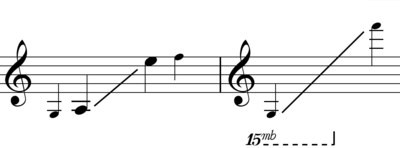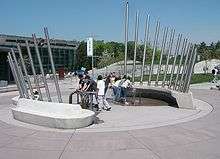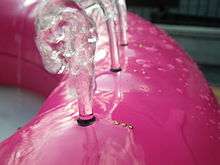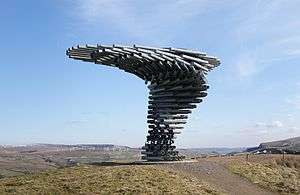Hydraulophone
|
Ryan Janzen, playing with Hart House Symphonic Band | |
| Other instrument | |
|---|---|
| Other names | Woodwater instrument |
| Classification |
|
| Hornbostel–Sachs classification |
NaN (Hydraulophone) |
| Playing range | |
|
Basic range of a diatonic hydraulophone with 12 water jets:  | |
| Related instruments | |
| Musicians | |


A hydraulophone is a tonal acoustic musical instrument played by direct physical contact with water (sometimes other fluids) where sound is generated or affected hydraulically.[1][2][3][4][5][6] Typically, sound is produced by the same hydraulic fluid in contact with the player's fingers.[7] The term also refers to an acoustic sound-producing mechanism used as an interface or input device involving the monitoring of fluid flow. Examples include hydraulophones for fluid-flow monitoring and measurement applications, such as building automation, equipment monitoring, and the like (for example, determining which faucet or toilet in a building is operating and how much water it is consuming).[8] The hydraulophone in the first sense was invented and named by Steve Mann, and has been used as a sensory exploration device for low vision individuals.[9]
Types of hydraulophone and basic operation
The term may be applied based on the interface used to play the instrument, in which a player blocks the flow of water through a particular hole in order to sound a particular note, or based on a hydraulic sound production mechanism. Hydraulophones use water flow sound producing mechanisms. They have a user interface, which is blocking water jets to produce sound. Those described in Mann's paper Hydraulophone design considerations[4] use water jets striking perforated spinning disks, shafts, or valves, to create a pulsating water flow, similar to a siren disk. A single disk, shaft, or valve assembly can have rings or passages with different numbers of holes for different notes. Some hydraulophones have reeds (one or more reed for each finger hole) and some are reedless, having one or more fipple mechanism[4] associated with each finger hole, thus having no moving parts to wear out.
Blocking flow through a finger hole directs the water instead to one or more of the above-described sound-production mechanisms, or resulting changes in flow or pressure affect a separate sounding mechanism associated with each finger hole.[4]
Some hydraulophones include an underwater hydrophone pickup to allow the sounds produced by the water to be electrically amplified. Electric amplification allows effects to be added (as with an electric guitar) as well as making the hydraulophone a hyper-acoustic instrument (that is, using computation to change the acoustic sound of the water into some other instrument).[10]
Relationship to woodwind instruments
The hydraulophone is similar to a woodwind instrument, but it runs on incompressible (or less compressible) fluid rather than a compressible gas like air. In this context hydraulophones are sometimes called "woodwater" instruments regardless of whether or not they are made of wood (as woodwind instruments are often not made of wood).
Hydraulophone embouchure
The water must be "blown" into the hydraulophone by way of a pump which can be hand-operated, wind operated, water powered, or electric. Unlike woodwind instruments in which there is one mouthpiece at the entrance to the flute chamber, hydraulophones have mouthpieces at every exit port from the chamber.
Whereas internal ducted flutes have one fipple mechanism for the mouth of the player, along with several finger holes that share the one fipple mechanism, the hydraulophone has a separate mouth/mouthpiece for each finger hole. A typical park-hydraulophone for installation in public spaces has 12 mouths, whereas a concert hydraulophone typically has 45 mouths.
Embouchure is controlled by way of the instrument's mouths, not the player's mouth such that the player can sing along with the hydraulophone (i.e. a player can sing and play the instrument at the same time). Moreover, the instrument provides the unique capability of polyphonic embouchure, where a player can dynamically "sculpt" each note by the shape and position of each finger inserted into each of the mouths. For example, the sound is different when fingering the center of a water jet than when fingering the water jet near the periphery of the circular mouth's opening.
12-jet diatonic hydraulophones
Many diatonic hydraulophones are built with 12 water jets, one for each of the 12 notes. The standard compass starts on A, extending up an octave and a half to E.

The standard A to E range, in which it is possible to play with polyphonic embouchure on any or all diatonic notes at the same time, is shown on the left side of the diagram. When playing only monophonically, some additional range is possible on certain hydraulophones, indicated here by small cue notes at the end-points.
Left, the extended notes come from closing key change valves or flexing key change levers, for sharpener, and flattener. To play a low G, one must be playing in C minor (with A♭) and close the flattener valve simultaneously. When playing on the high E jet, closing the sharpener valve produces an F.
With change-valves, the diatonic hydraulophone is polyphonic in the same sense as a so-called "chromatic harmonica" – you can play chords and move all members of a chord down one semitone or up one semitone together, but the function of the valves is usually not separated to work on a per-note basis, so for example, you can play an A-minor chord, and flex the entire chord down to A-flat minor, but you can't easily play an A major chord without the use of polyphonic embouchure to bend only the middle note to a C♯ (which requires more skill than the average hydraulist has). Thus the "diatonic" hydraulophone is called "diatonic" conservatively to "under promise and over-deliver".
Finally, on the right, the additional extended range comes from the two octave-change valves (all notes can be shifted as many as two octaves down, or one octave up).
45-jet chromatic hydraulophones (concert hydraulophones)

Whereas park and pool hydraulophones are usually 12-jet diatonic, concert-hydraulophones are usually 45-jet chromatic.
45-jet hydraulophones have a 3½ octave range of A to E, chromatic, plus an additional A-flat below the lowest A. The playing compass (45 water jets) is the same as the sounding range (45 notes).
12-jet hydraulophones are installed in public spaces, but there is a 45-jet south hydraulophone at the Ontario Science Centre, a concert-hydraulophone having this precise range and compass.
Themed hydraulophones
As public art installations, hydraulophones can be made in various themes and designs. An example of a theme-specific hydraulophone is the Aquatune located at the main entrance to the Legoland waterpark in Carlsbad California. This hydraulophone, which Legoland describes as "a musical water stand",[11] is the centerpiece of the entranceway, and is flanked on either side by educational installation exhibits, such as water tables where participants can build water dams from lego blocks, and learn about laminar and turbulent flows through various flow channels.
Cold weather hydraulophones



Hydraulophones may be built into hot tubs for use in cold weather. This solves the problem of keeping the hydraulist warm, as well as keeping the hydraulic fluid (e.g. water) heated by way of standard pumping and heating equipment. In this kind of hydraulophone (e.g. balnaphone, from the Greek "balnea" meaning "bath") the hydraulist is immersed in the hydraulic fluid used by the instrument.

Relationship to the pipe organ
Many hydraulophones include a separate water-filled pipe for each note, and have sound-production means similar to pipe organs (but with water rather than air), while maintaining the flutelike user-interface (finger embouchure holes).
This form of hydraulophone is similar to an organ, but has water flowing through the pipes instead of air flowing through the pipes.
Relationship to the piano
On a concert hydraulophone, the finger holes are arranged like the keys on a piano, i.e. there is a row of uniformly spaced holes close to the player, and a row of holes that are in groups of 2, 3, 2, 3, ..., a little further from the player. Whereas the piano and organ both have a similar kind of keyboard layout, the response ("key action") is different. Pianos tend to respond to velocity (how quickly a key is struck), whereas organs tend to respond to displacement (whether or not a key is pressed down). Hydraulophones tend to respond to the time-integral of displacement (total water flow), as well as to displacement, velocity, and to some degree jerk and jounce .

Relationship to instruments that use other states of water

The hydraulophone uses liquid, typically water. It is thus related to the pagophone, an instrument that uses ice, and the calliope, an instrument that uses steam.
World's largest hydraulophone

Presently the world's largest hydraulophone is the main architectural centerpiece out in front of the Ontario Science Centre, one of Canada's landmark architecture sites. It is also Toronto's only freely accessible aquatic play facility that runs 24 hours a day. This hydraulophone may not be present during the winter months.
Markings on standard 12-jet hydraulophone

Because the water-spray from hydraulophones obscures vision (or because hydraulophones are played underwater where visibility is poor), finger holes are sometimes encoded in Braille. Braille has the added advantage that the one-to-one correspondence between letters and numbers is the same as the standard A-minor hydraulophone, i.e. jet 1 is A, jet 2 is B, jet 3 is C, etc.. The skill (intricate sense of tactility) needed to play a hydraulophone well is also similar to the skill needed to read Braille.
![]()
![]()
![]()
![]()
![]()
![]()
![]()
![]()
![]()
![]()
![]()
![]()
(12 sets of dots typically made from brass pins above each finger hole)
Percussion hydraulophone
Most hydraulophones sound continuously for as long as a finger hole is blocked. However, the WaterHammer hydraulophone produces sound from impact (water hammer) that dies down after being initially struck, thus sounding more like a piano than the more typical "underwater pipe organ" hydraulophone.
The WaterHammer Hydraulophone is a hydraulophone (water-based musical instrument) that uses the water hammer principle for hard-hitting percussive musical notes.[12][13]
See also
Notes
- Note the spelling of hydraulophone, as opposed to hydrophone.
References
- ↑ The Grove Dictionary of Musical Instrument. Publisher: Oxford University Press. Print Publication Date: 2016. The Grove Dictionary of Musical Instruments Vol. 2, Pg. 738, Edited by Laurence Libin Print ISBN 9780199743391
- ↑ "Fluid Melodies: The hydraulophones of Professor Steve Mann" In WaterShapes, Volume 10, Number 2, Pp36–44, New York, NY, USA. Volume 10, No 2, 2008 February
- ↑ Mann, Steve. "Acoustic, hyperacoustic, or electrically amplified hydraulophones or multimedia interfaces." U.S. Patent 8,017,858, issued September 13, 2011.
- 1 2 3 4 Mann, S. "Hydraulophone design considerations: absement, displacement, and velocity-sensitive music keyboard in which each key is a water jet" (PDF). Proceedings of 14th annual ACM international conference on Multimedia. Santa Barbara, CA, USA: International Multimedia Conference archive: 519–528. Oct 27, 2006
- ↑ Mann, Steve, Ryan Janzen, Jason Huang, Matthew Kelly, Lei Jimmy Ba, and Alexander Chen. "User-interfaces based on the water-hammer effect: water-hammer piano as an interactive percussion surface." In Proceedings of the fifth international conference on Tangible, embedded, and embodied interaction, pp. 1-8. ACM, 2011.
- ↑ Mann, Steve, and Ryan Janzen. Polyphonic embouchure on an intricately expressive musical keyboard formed by an array of water jets. Ann Arbor, MI: Michigan Publishing, University of Michigan Library, 2009.
- ↑ Mann, S. "flUId Streams: Fountains that are keyboards with nozzle spray as keys...", Proceedings of ACM Multimedia 2005, Pp. 181–190, Singapore.
- ↑ Janzen, R. and Mann, S. "Arrays of water jets as user interfaces: Detection and estimation of flow by listening to turbulence signatures using hydrophones", Proceedings of the 15th International Conference on Multimedia, Pp. 505–508, Augsburg, Germany, 2007.
- ↑ Nolan, J.; Mann, S.; Bakan, D. (2012). "First Splashes in the Frolic Lab: Exploring Play-based Learning, Water and Sound with Nessie the Hydraulophone". Children, Youth and Environments. 22 (2): 263–272.
- ↑ "The Electric Hydraulophone: An acoustic hyperinstrument with feedback", International Computer Music Conference, Pp. 162, Copenhagen, Denmark.
- ↑ "Imagination Station - LEGOLAND", (Accessed 15 September 2015).
- ↑ US Patent 8,017,858
- ↑ "User-interfaces based on the water-hammer effect", ACM (Association of Computing Machinery) conference on Tangible Embedded and Embodied Interaction. ISBN 978-1-4503-0478-8.
External links
- http://wearcam.org/osc/opening – Site devoted to world's largest hydraulophone, including opening day celebrations, etc..
- Ontario Science Centre website for Teluscape and its main centerpiece, the circular hydraulophone sculpture.
- Hacked Gadgets article on hydraulophones


